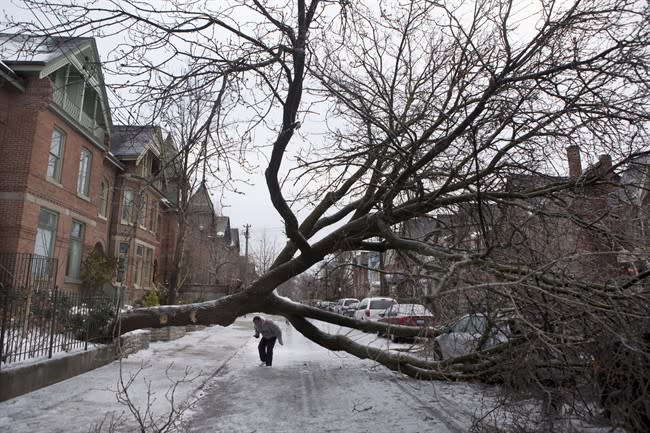Ice storm likely to push insured damages to record $3 billion in 2013

Suffice to say an icestorm, such as the one that slammed into Ontario and across the eastern provinces Sunday, is not how Canadians had hoped to wrap up 2013.
In the Greater Toronto Area, among the worst-hit regions, phone calls and emails are only now beginning to pour into insurance companies as residents assess damage to their homes and cars caused mainly by trees and branches laden with heavy layers of ice.
Insurers say it’s too early to make any accurate predictions on just how much this latest storm will cost. This year was already on track to be the priciest yet for Canada in terms of the number of claims stemming from extreme weather events.
Insurance losses related to Alberta’s devastating floods in June and Toronto’s record rainfall in July are estimated to reach $1.7 billion and $900 million, respectively.
Add in the icestorm and “we are going to see a year of insured damages in excess of $3 billion for the first time ever,” said Steve Kee, spokesman for the Insurance Bureau of Canada.
Storm packs a wallop for holiday season
Retailers, too, are nervously crunching the numbers. The storm is expected to put a serious dent in pre-Christmas sales.
December sales stemming from retail and grocery shopping represent $30 to $40 billion in Canada, according to the Retail Council of Canada. Significant disruptions to business could mean the difference to many retailers, particularly small and mid-sized businesses, between ending the year in the black or the red.
David Ian Gray, a retail analyst with DIG360, said chain and owner-operated stores in areas impacted by the storm will likely see fewer sales in the critical shopping days before Christmas, with lingering power outages and icy roads combining to keep holiday shoppers at home.
But Gray said neighbourhood stores may actually benefit from residents in search of last-minute holiday groceries and gifts. As the clean-up continues, he said Christmas Eve could prove a very busy day at the malls.
A hit to GDP?
Benjamin Tal , deputy chief economist with CIBC World Markets, said it was “very likely” the economic impact of the current icestorm on overall GDP will be negligible.
A rush of post-holiday sales will likely offset any reductions at the tills in the days leading up to Christmas.
Tal said it’s worth looking at past disasters to see how the latest storm will impact the economy. Among his findings:
The 1998 ice storm that hit Quebec and eastern Ontario is estimated to have lowered January 1998 GDP by 0.2-0.3 percentage point. The main impact was on construction activity and to a lesser extent manufacturing. However, usually the long term impact of natural disasters is a net positive. The repair activity followed the storm is estimated to have contributed just over 0.1 percentages point to overall GDP growth in 1998.
The Alberta floods, was less disruptive in terms of its economic impact. The impact on overall Canadian annual GDP during the month of June was estimated to be between 0.1-0.2 percentage point on annual GDP in June while the impact on 2013 annual GDP growth as a whole was probably negligible or slightly positive.

 Yahoo Finance
Yahoo Finance 
